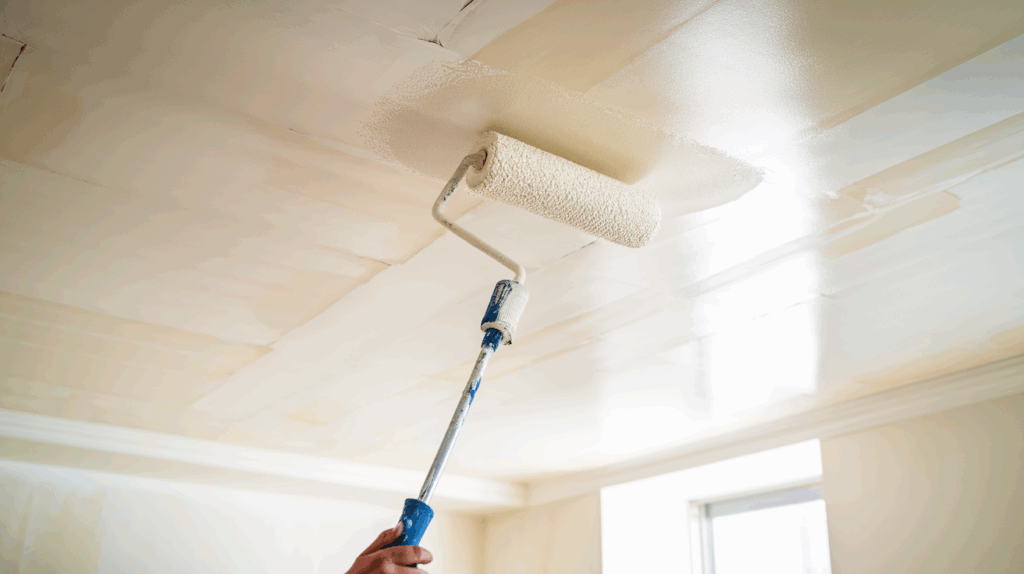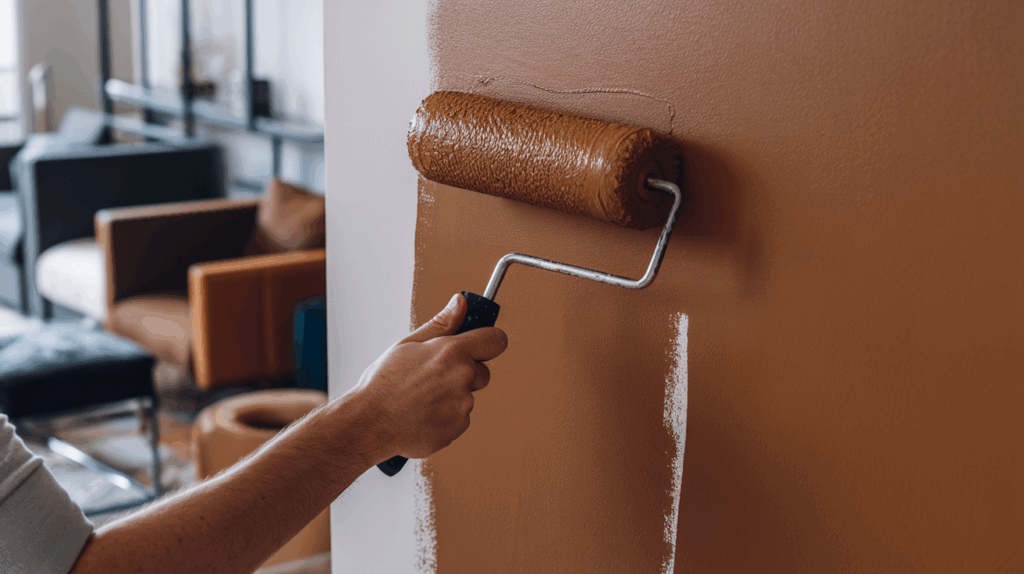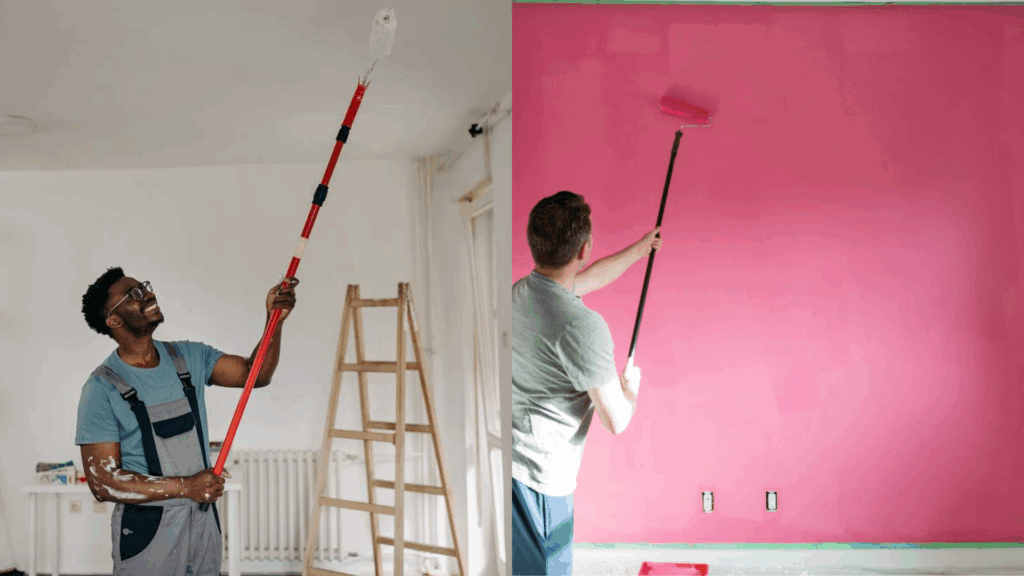When I started planning to repaint my home, I assumed I could just use the same paint for both the walls and the ceilings. It felt like a good way to save time and maybe even a little money.
But the more I looked into it, the more I realized that ceiling paint and wall paint are not the same thing.
Each one is designed for a different purpose, and using the right type in the right place can make a big difference in how everything looks and lasts.
Ceiling paint is thicker, flatter, and made to stay put without dripping.
Wall paint, on the other hand, offers a wide range of finishes and colors made for everyday use and cleaning.
Understanding these differences helped me get better results and avoid problems down the road.
Ceiling Paint Overview

Ceiling paint is specially designed for overhead surfaces with a thicker consistency to reduce drips and splatter during application.
Most ceiling paints come in a flat or matte finish, which helps hide imperfections like cracks or uneven textures.
Typically available in white or soft off-white, ceiling paint brightens rooms and creates the illusion of more space.
Unlike wall paint, it doesn’t need to be washable or stain-resistant, as ceilings experience less contact.
For an even, professional finish overhead, ceiling paint offers the ideal balance of function and coverage.
Wall Paint Overview

Wall paint is designed for vertical surfaces, with a thinner consistency that allows for smooth, even application.
It comes in various finishes, matte, eggshell, satin, semi-gloss, and gloss, each serving a specific purpose.
Matte is great for hiding flaws in bedrooms or living rooms, while satin or semi-gloss is better for high-traffic areas like kitchens and bathrooms.
The wide range of colors makes it easy to match any style or design theme.
Most wall paints are water-based, offering quick drying, low odor, and easy cleanup, making them ideal for both DIY and professional projects.
Key Differences: Ceiling Paint vs. Wall Paint
Understanding how ceiling paint differs from wall paint helps ensure you get the right finish, performance, and durability for each surface.
1. Understanding Paint Viscosity
Ceiling paint is made with a thicker consistency to reduce drips and splatter during overhead application.
Its high viscosity allows it to stay in place and cover small imperfections like cracks or texture variations.
Often requiring fewer coats, it saves both time and effort. The flat finish reduces light reflection, creating a smooth, clean, and even ceiling surface.
Wall paint has a thinner, more fluid texture that makes it easy to apply smoothly on vertical surfaces using brushes or rollers.
This versatility allows for creative design choices, while its formulation supports blending and layering for bold colors and detailed techniques.
2. Finish and Reflectivity
Ceiling paint typically has a flat or matte finish designed to reduce glare from overhead lighting.
This non-reflective surface helps hide minor imperfections like patches or uneven textures.
The flat sheen creates a smooth, uniform look that draws less attention to the ceiling, making it ideal for most living spaces, especially bedrooms, living rooms, and hallways.
Wall paint is available in a range of finishes, including matte, eggshell, satin, semi-gloss, and gloss. Each finish offers different levels of shine and durability.
Matte hides imperfections well, while satin and semi-gloss are easier to clean and resist moisture.
This variety allows you to match the paint’s look and function to each room’s specific needs and traffic levels.
3. Color Availability
Ceiling paint is typically available in white or off-white tones. These light colors help reflect natural and artificial light, making rooms feel brighter and more spacious.
The limited palette is intentional, as it draws attention away from the ceiling and helps maintain a clean, unobtrusive look that complements almost any wall color or interior design style.
Wall paint offers a wide selection of colors, making it easy to personalize each room. From soft neutrals to bold, vibrant shades, wall paint can reflect your style and mood.
This variety also allows for seamless coordination with furniture, flooring, and décor, giving you full control over your home’s visual impact and ambiance.
4. Durability and Maintenance
Ceiling paint is made to provide solid coverage and visual smoothness, not frequent cleaning.
Since ceilings are rarely touched, the paint doesn’t need high resistance to stains or scuffs.
Its durability lies in long-lasting color and texture, ensuring ceilings remain clean-looking with minimal upkeep.
Wall paint is formulated to withstand daily use, making it ideal for high-traffic areas. It resists scuffs, stains, and moisture, and can be cleaned regularly without damage.
This durability makes it perfect for rooms like kitchens, hallways, and bathrooms, where walls are more likely to be touched or exposed to dirt and humidity.
5. Functional & Aesthetic Differences
Ceiling and wall paints serve unique purposes beyond just color; they differ in how they resist moisture, handle cleaning, and contribute to your home’s visual appeal.
| Aspect | Ceiling Paint | Wall Paint |
|---|---|---|
| Mold & Mildew Resistance | Some formulations include mold- and mildew-resistant additives for humid spaces | Typically less resistant, unless using specialized bathroom/kitchen formulas |
| Washability | Not designed for regular cleaning; low washability due to limited contact | High washability and scrub-resistance for easy maintenance in high-traffic areas |
| Cleaning Needs | Rarely cleaned due to low exposure | Needs regular cleaning in areas like kitchens, hallways, and kids’ rooms |
| Aesthetic Role | Provides a clean, subtle background that reduces glare and hides imperfections | Adds personality and style with colors and finishes that define the room |
| Lighting Impact | Flat finish minimizes light reflection for a smooth, non-distracting look | Various finishes can reflect or absorb light to affect the room’s brightness |
Techniques for Applying Ceiling vs. Wall Paint
Applying ceiling paint is more physically demanding because you’re working overhead.
The paint’s thicker consistency helps reduce drips, but you still need the right tools, like a roller with an extension pole and a drip-resistant cover, to achieve even results.
Drop cloths and masking are especially important, as splatter is more likely.
Wall painting, on the other hand, is generally easier. Gravity works in your favor, so the paint spreads more evenly without as much risk of dripping.
Standard brushes and rollers are usually enough, and there’s less need for overhead protection. The process is also more forgiving, especially for beginners.
Touch-ups and blending are easier on vertical surfaces, making wall painting more accessible for DIYers looking for clean, professional-looking results with fewer complications.
Ceiling vs. Wall Paint: Cost Considerations
Ceiling and wall paints differ not just in function but also in cost efficiency, depending on coverage, application needs, and finish requirements.
| Aspect | Ceiling Paint | Wall Paint |
|---|---|---|
| Cost per Gallon | Slightly higher due to a thicker, drip-resistant formula | Generally lower, but varies by finish and brand |
| Coverage Efficiency | Covers more area with fewer coats on smooth ceilings | May require multiple coats for full, even coverage |
| Finish Variety | Usually flat or matte; limited finish options | Available in multiple finishes (matte to gloss) |
| Application Needs | Formulated to reduce drips and splatter during overhead use | Easier to apply on vertical surfaces; more forgiving for beginners |
| Overall Value | Higher upfront cost may balance out with fewer coats and labor savings | Flexible pricing and styles, but may require more paint and prep in some cases |
Is Ceiling Paint Worth Investing In Compared to Regular Wall Paint?
Ceiling paint is worth the investment for a clean, lasting finish overhead.
While using leftover wall paint may seem like a cost-saving option, it can lead to uneven results, drips, and visible imperfections.
Ceiling paint is thicker, resists splatter, and features a flat, low-reflective finish that hides flaws and minimizes glare, something wall paint can’t do as effectively.
Though it may cost more per gallon, ceiling paint offers better coverage with fewer coats, saving time and effort in the long run.
Expert Recommendations
Choosing the right paint for each surface is key to achieving a lasting, professional-quality finish.
- Ceiling Paint: Designed specifically for overhead surfaces to minimize drips and provide even, glare-free coverage.
- Flat Finish: Preferred by pros for its ability to hide flaws and reduce reflection on ceilings.
- Wall Paint: Best for vertical applications where a wide range of finishes and colors can enhance the room’s look.
- Purpose-Specific Formulas: Help avoid common mistakes and lead to better results with fewer coats and corrections.
- Long-Term Benefits: Using the right paint saves time and effort by reducing the need for frequent touch-ups or repainting.
Conclusion
From my own experience, using ceiling-specific paint really makes a difference. It gives a smooth finish, hides imperfections, and lasts without frequent touch-ups.
While using wall paint may seem easier, each type is made for a specific purpose.
Wall paint provides the color and finish for vertical surfaces, while ceiling paint focuses on coverage, control, and low-glare performance.
Choosing the right paint helps avoid issues like drips and uneven texture.
A small investment in the right paint now can save you time, money, and effort later. If you’re unsure, feel free to reach out. I’m happy to help!
Frequently Asked Questions
What happens if I use wall paint on the ceiling?
Wall paint can drip more easily and reflect light unevenly on ceilings. It may also highlight flaws rather than hide them, leading to a less polished finish.
Can I use ceiling paint on walls?
Technically, yes, but it’s not recommended. Ceiling paint is flat and less durable, so it won’t hold up well to cleaning or regular wear on walls.
Why is ceiling paint usually flat?
Flat paint hides imperfections and reduces glare from overhead lights. It helps ceilings look smooth and uniform, even if the surface isn’t perfect.

